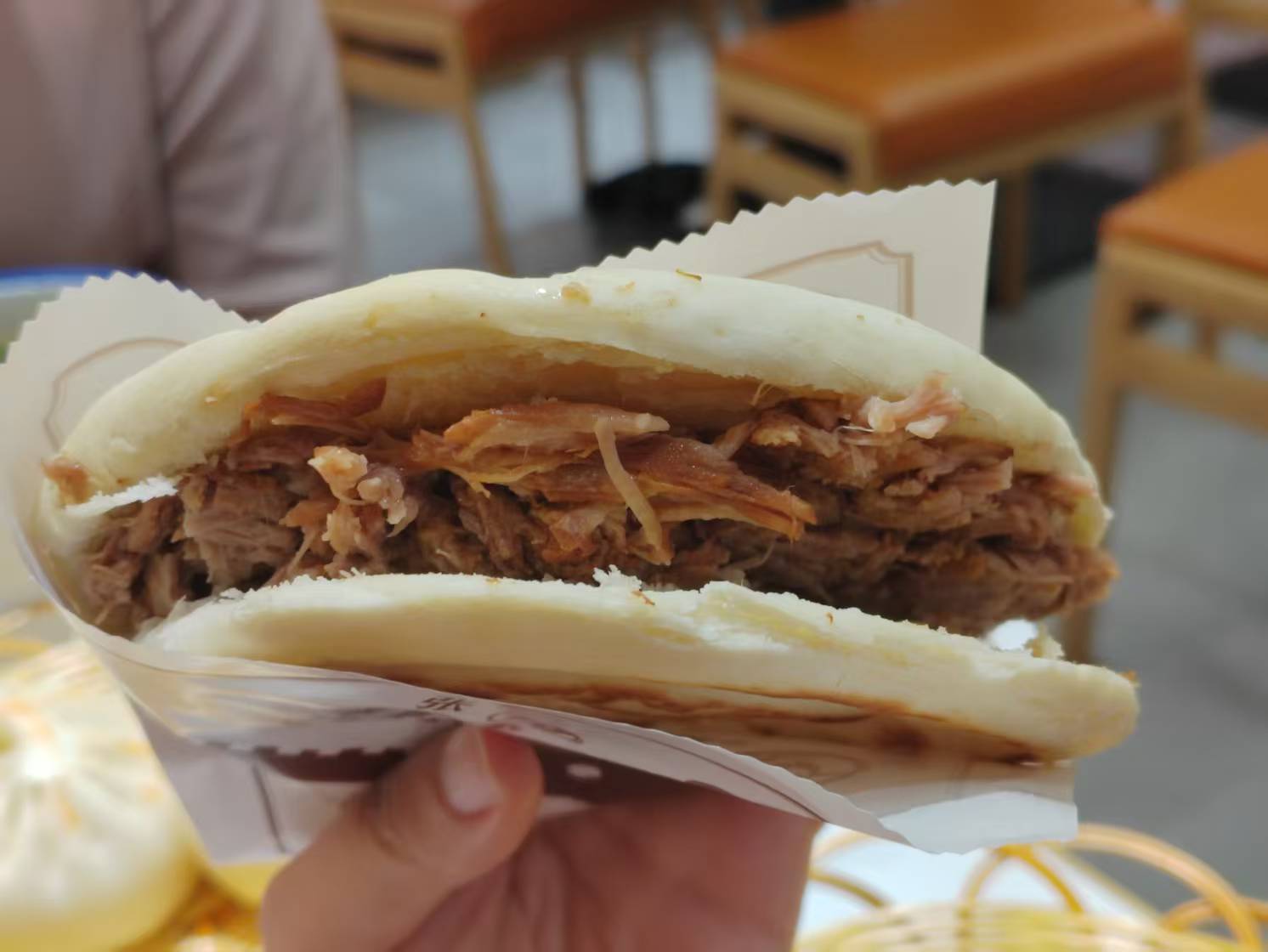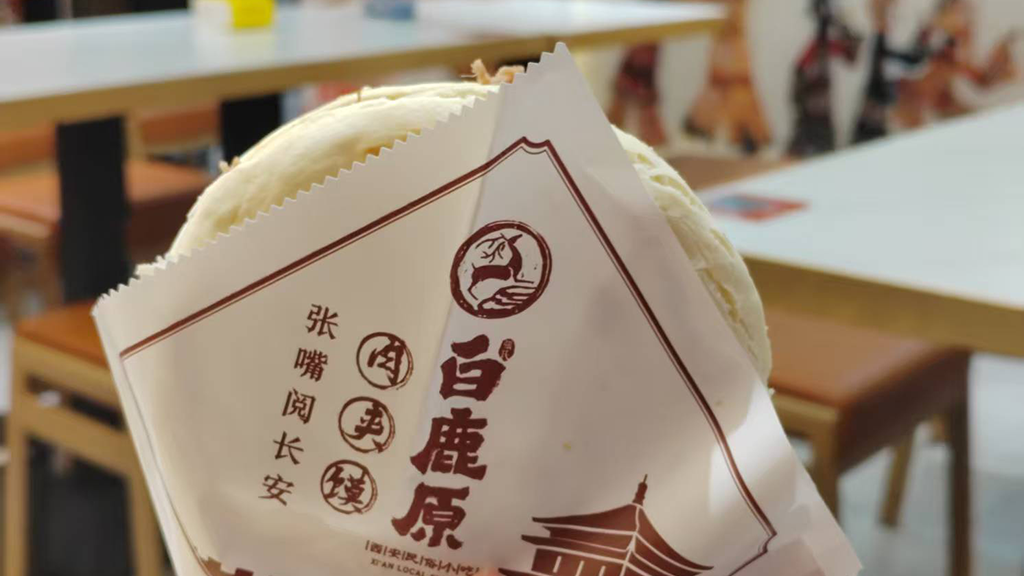Do you love burgers? Do you enjoy the rich, savory taste of braised meat? If you like both, then you absolutely can’t miss China’s traditional (hamburger) meat sandwich—Rou Jia Mo!
What is Rou Jia Mo?
Rou Jia Mo is one of China’s traditional specialties, often referred to as a “meat-stuffed steamed bun.” The method of splitting open a steamed bun (or sesame cake) and adding ingredients inside is known as “jiamo.” This concept is similar to that of a hamburger, which is why Rou Jia Mo is sometimes called the Chinese hamburger.
The Chinese name for Rou Jia Mo is quite intriguing. The “jia” in “Rou Jia Mo” is pronounced as “jiā,” meaning “to plug or fill.” The word order in Chinese imperative sentences typically follows a left-to-right sequence, so “Rou Jia Mo” literally translates to meat sandwiched between steamed buns, rather than steamed buns sandwiched between meat. But why is it called “Rou Jia Mo” instead of “Mo Jia Rou”?
The answer lies in the pronunciation. When said quickly in the Shaanxi dialect, “Mo Jia Rou” can sound like “Mo Jia Rou,” which in Chinese could be interpreted as “no meat in the steamed bun” (“Mo” meaning “don’t”). On the other hand, “Rou Jia Mo” clearly emphasizes the presence of meat. Shaanxi people, with their clever linguistic tricks, ensure that the name reflects a bun filled generously with meat.
You can play the audio to listen to the chinese pronounciation of Rou Jia Mo.
The Rou Jia Mo’s 2,000-Year History
In 2015, the American Huffington Post published an article in which food writer Alison Spiegel claimed that the world’s first hamburger didn’t originate in the United States or Germany, but in China. She was referring to Rou Jia Mo.
The article stated that Rou Jia Mo, made by stuffing chopped meat into an open round cake, dates back to the Qin Dynasty.

However, the history of Rou Jia Mo may not be quite that long. While both the preserved meat (used as the filling in Rou Jia Mo) and the cake itself have been documented for centuries, the earliest clear written record of placing preserved meat inside a steamed bun dates back to the early 1900s. Nevertheless, the ingredients of Rou Jia Mo certainly have a long history.
How Rou Jia Mo is Evolved? Types of Rou Jia Mo
Over time, Roujiamo has evolved, with variations in both the bread and the filling. As a result, we can categorize it based on either the type of bread or the style of meat filling.
The pancake for Baijibing Rou Jia Mo is made from leavened dough, resulting in a crispy exterior and a tender interior. This version is an old-school classic, featuring cured meat that is exceptionally delicious.
Personally, I prefer the Tongguan Rou Jia Mo because it has a crispier texture, which is why it’s especially popular among young people. On the other hand, older generations tend to favor Baijibing Rou Jia Mo.

The types of meat fillings are quite diverse, including:
- Cured pork (Fatty& Lean OR Lean Pork)
- Cured beef
- Cured lamb
- Beef in sauce
- Stir-fried pork with cumin
- Steamed pork with rice flour
- Steamed beef with rice flour
- Stir-fried lamb liver
- Cumin Chicken
- …
For Muslims or those who do not eat pork, it is recommended to choose Roujiamo made with lamb or beef from halal restaurants. These options are also incredibly delicious!
It’s worth noting that when you buy Rou Jia Mo outside of Shaanxi Province, the meat filling often includes chopped green peppers, which authentic Shaanxi natives dislike—much like Italians reacting to pineapple on pizza. However, as the popularity of green pepper pork Rou Jia Mo grows (the green peppers add a touch of greasiness), I’ve noticed that even in Shaanxi, green peppers are sometimes offered as an option.
Modern versions of Rou Jia Mo often include vegetables, such as potato slices and dried tofu, offering even more variety. For those who prefer to avoid fatty meat, Xi’an often offers Rou Jia Mo made with pure lean pork. There’s bound to be a version that suits your taste!
Famous Restaurants to Eat Rou Jia Mo in Xi’an
I found a few of the highest-rated Rou Jia Mo restaurants on China’s local review platforms for your reference:
- 翔子米皮(黄雁村店)
- 子午路张记肉夹馍(翠华路店)
- 赵亚东赵记腊汁肉店(丰登南路总店)
- 李老四腊牛肉夹馍(韩森路店)
- 王魁腊汁肉店(总店)
- 樊记腊汁肉夹馍(竹笆市站)
- 魏家凉皮(南门店)
- 胡老大米皮(长丰园店)
- 邢老三肉丸胡辣汤(西安总店)
- 八哥油茶麻花(朱雀大街店)
You can simply enter the name of any of these top-rated stores into your navigation app, choose the nearest one, and give it a try.
Final Words
The renowned Chinese director Zhang Yimou hails from Xi’an, Shaanxi. The famous actress Zhang Ziyi once mentioned that his favorite food is Rou Jia Mo. During the preparations for the 2012 Olympic Games, Zhang Yimou had Rou Jia Mo for lunch every day.
We invite everyone to visit Shaanxi, China, to taste this delicious Chinese hamburger—Rou Jia Mo. You won’t be disappointed!

